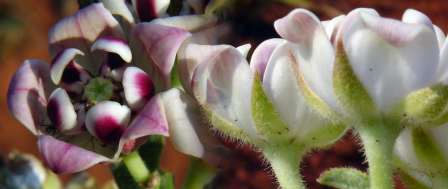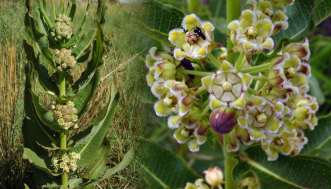Pachycarpus schinzianus
Pachycarpus schinzianus (Schltr.) N.E.Br.
Family: Apocynaceae
Common names: cream cups (Eng.); bitterwortel (Afr.)
Introduction
In spring and summer Pachycarpus schinzianus and Xysmalobium undulatum are the two largest and most readily distinguished asclepiads in the grasslands of the northern provinces of South Africa. Of these, Pachycarpus schinzianus has by far the most beautiful flowers.

Description
Description
Pachycarpus schinzianus is a rough-textured, erect perennial herb, 0.3 to 0.6 m tall, that resprouts from an underground rootstock.

The leaves are simple, large, lanceolate and leathery, with rough hairs. They are up to 100 mm long, with wavy margins usually with a red or maroon edge.

The flowers are large, cup-shaped , with recurved upper tips and are carried in clusters of about four on the tips of the branches. The flowers are cream-coloured to yellowish to pink. The corona always has a maroon blotch on the channelled inside.
The plants contain thick milky latex which is secreted wherever a plant is damaged; it contains a glycoside that is extremely bitter (hence the common name). The bitterwortel flowers from September to February and is common throughout the grasslands of the highveld. The fruit is an inflated follicle which is usually solitary as a result of abortion after fertilization; it is spindle-shaped, 50–70 mm long, contains 5–7 lateral wings and is hairless. The fruit contains many brown seeds.
Conservation Status
Status
Pachycarpus schinzianus is currently not protected or threatened. The centre of distribution, however, is in Gauteng Province where the grasslands are increasingly under threat of human impact. It is also widely harvested and is fast disappearing (like many other medicinal plants). These two factors may influence the future status of the species.
Distribution and habitat
Distribution description
This endemic species is widespread in the grassland and savanna of South Africa in Free State, Gauteng, KwaZulu-Natal, Limpopo, Mpumalanga and the North-West Provinces.
Derivation of name and historical aspects
History
Pachycarpus is derived from the Greek words pachys (thick) and karpos (fruit). The epithet schinzianus honours the well-known Swiss botanist Hans Schinz, who collected extensively in Namibia. The common name bitterwortel is sometimes also used for Xysmalobium undulatum, which is a member of the same family and has more or less the same medicinal uses.
Ecology
Ecology
The thick underground rootstock is essential for the survival of the plants during the cold winter months and is also a mechanism that helps to avoid destruction of the entire plant during the fires that are common throughout the distribution range. The flowers produce much nectar through nectaries at the base of the corona. This attracts a host of possible pollinators and scavenging ants. A variety of organisms parasitize and feed on this plant.

The seeds contain a tuft of hairs called a coma which forms a parachute-like structure at the tip of the seed and is instrumental in the wind-dispersal syndrome exhibited by these plants.

Uses
Use
Medicinally widely used in remedies for many ailments. The Manyika tribe uses it as a remedy against syphilis and to aid conception. Powdered root is a Dutch remedy for haemorrhoids. Concoctions of the roots have been used to treat dropsy, dysentery and even snakebite. The milky latex is rubbed on animal skins before they are set out to dry to prevent dogs from tearing them. Crushed leaves are also rubbed on the legs to repel dogs.
The rootstock is mixed with the pounded root of Xysmalobium undulatum to make Uzara medicine, which is used for diarrhoea, dysentery and to soothe post-natal cramps. It is also used as a tonic for the cardiovascular system.
All parts of the plant are extremely bitter and are used in various decoctions and infusions as an emetic, diuretic and purgative. Zulu people use the roots for indigestion, malaria and other fevers (including typhoid fever). Xhosas use infusions of the root for colic and abdominal troubles and sniff the dried pounded roots to relieve headaches.
Browsed plants are frequently encountered in the wild. However, experiments have shown the plants to be poisonous to sheep and guinea-pigs, which died within one to two days after consuming the plants.
Growing Pachycarpus schinzianus
Grow
As with many members of this family that have a deep rootstock, it is quite difficult to cultivate the plants. Plants of Pachycarpus generally have some of the most spectacular flowers in the sub-family Asclepiadoideae and are not in general cultivation. The flowers last but a few days, the fruit and stems are not very attractive and the stems die back after fruiting and in the colder months. All this probably discourages growers from attempting cultivation. The various species are furthermore prone to infestation by various insects.
References
- Germishuizen, G. & Fabian, A. 1997. Wildflowers of northern South Africa. Fernwood Press, Vlaeberg, Cape Town.
- Leistner, O.A. (ed.). 2000. Seeds plants of southern Africa: families and genera. Strelitzia 10. National Botanical Institute, Pretoria.
- Lucas, A. 1987. Wildflowers of the Witwatersrand. Struik Publishers, Cape Town.
- Pole Evans, I.B. 1926. Pachycarpus schinzianus. The Flowering Plants of South Africa 6: t. 210.
- Smith, C.A. 1966. Common names of South African plants. Memoirs of the Botanical Survey of South Africa No. 35.
- Van Wyk, A.E. (Braam) & Malan, S. 1997. Field guide to the wildflowers of the highveld. Struik Publishers, Cape Town.
- Van Wyk, B.-E. & Gericke, N. 2000. People’s plants: a guide to useful plants of southern Africa. Briza Publications, Pretoria.
- Watt, J.M. & Breyer-Brandwiyk, M.G. 1962. Medicinal and poisonous plants of southern and eastern Africa. Livingstone, Edinburgh and London.
Credits
S.P. Bester
National Herbarium
January 2008
Plant Attributes:
Plant Type: Perennial
SA Distribution: Free State, Gauteng, KwaZulu-Natal, Limpopo, Mpumalanga, North West
Soil type: Sandy, Loam
Flowering season: Spring, Early Summer
PH:
Flower colour: White, Pink, Cream
Aspect: Full Sun
Gardening skill: Challenging
Special Features:
Horticultural zones












Rate this article
Article well written and informative
Rate this plant
Is this an interesting plant?
Login to add your Comment
Back to topNot registered yet? Click here to register.